Introduction
The integration of artificial intelligence (AI) into cybersecurity represents a pivotal transformation in how organizations defend against an increasingly sophisticated landscape of threats. As cybercriminals harness AI technologies to enhance their malicious tactics, businesses must adapt by employing advanced AI-driven solutions that not only streamline threat detection but also bolster overall security frameworks.
This article delves into the multifaceted role of AI in cybersecurity, exploring its applications in:
- Threat response
- The challenges posed by its misuse
- The critical need for ethical considerations and regulatory compliance
With the stakes higher than ever, understanding the implications of AI in cybersecurity is essential for organizations striving to protect their digital assets in a rapidly evolving threat environment.
The Transformative Role of AI in Cybersecurity
The future of AI in cyber security is fundamentally transforming the cybersecurity environment by providing advanced tools and methodologies for risk detection and response. As AI usage among businesses has doubled in the past year, its capabilities in analyzing vast datasets in real-time become increasingly critical. These AI systems excel at recognizing patterns that may indicate potential threats, enabling organizations to react swiftly and effectively.
By utilizing machine learning algorithms, companies can automate risk detection processes, significantly reducing response times and enhancing overall protective measures. For instance, AI-driven systems are designed to learn from past cyber incidents, allowing them to adapt their defenses against evolving threats. This adaptability transforms traditional security protocols into dynamic, responsive frameworks.
Moreover, with alarming cyber statistics projected for 2024, the urgency for organizations to adopt AI-driven solutions becomes even more pronounced. Experts from the U.S. Department of Defense emphasize that the imminent battle of 'AI vs. AI' underscores the necessity for advanced strategies in digital security. In this context, improving logical reasoning skills through methodologies like game theory is crucial for professionals in the field.
Game theory can enhance decision-making and strategic thinking by providing a framework for anticipating and countering adversarial actions in security scenarios. Overall, the application of AI in digital security is not merely a trend; it signifies the future of AI in cyber security and a fundamental change in how companies safeguard their digital assets.
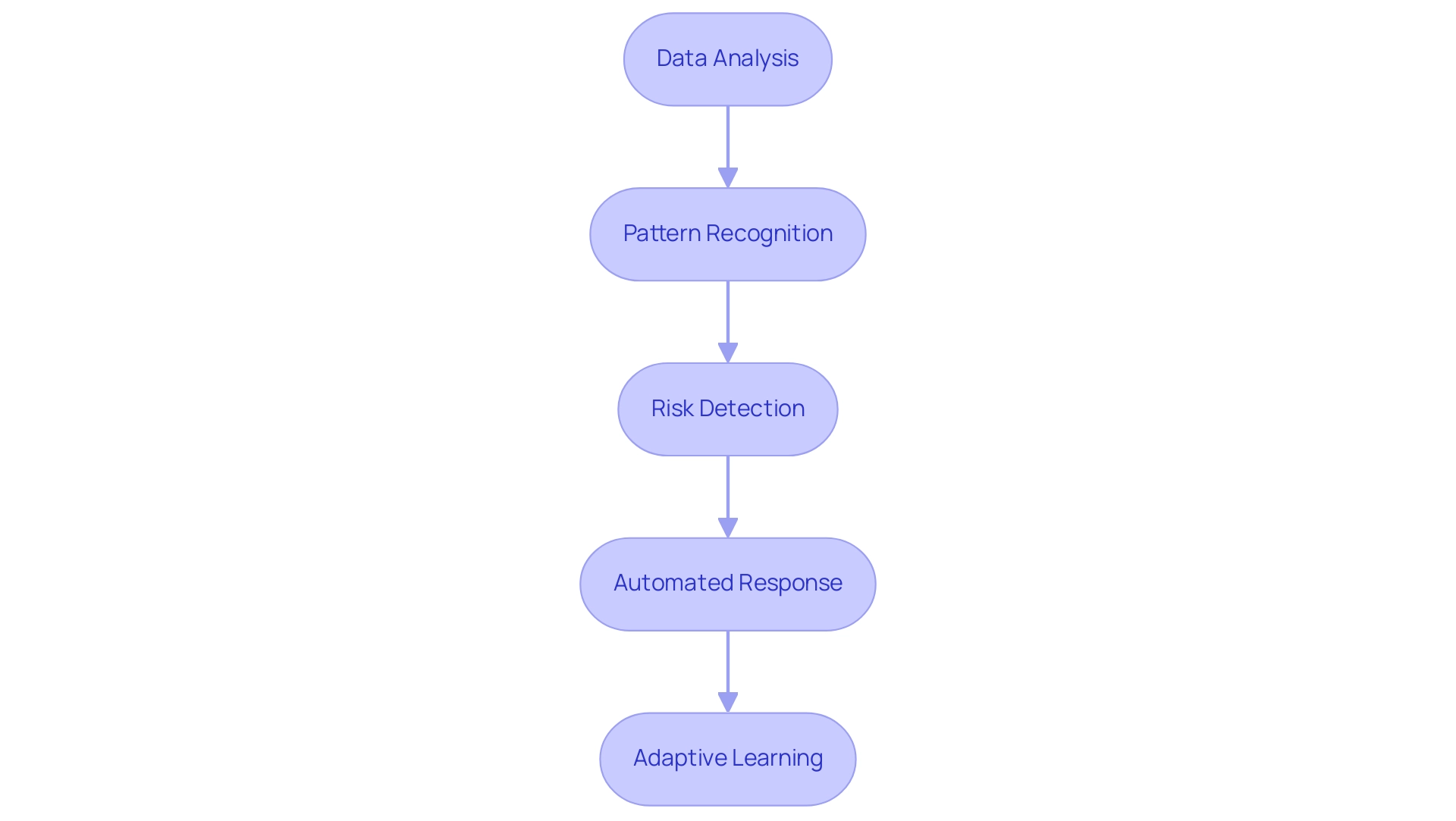
Emerging Threats: AI in the Hands of Cybercriminals
The increasing accessibility of AI technologies has marked a significant shift in the landscape of cybercrime, highlighting the importance of the future of AI in cyber security as criminals are empowered to execute more sophisticated attacks. The advanced techniques being utilized by cybercriminals, such as automated phishing, AI-generated deepfakes, and complex malware, highlight the challenges we face in the future of AI in cyber security. Notably, AI enables the creation of highly personalized phishing emails, making them substantially harder for recipients to identify as fraudulent.
According to recent statistics, the future of AI in cyber security is highlighted by a 50% surge in automated phishing attacks in 2024, as cybercriminals increasingly leverage AI to enhance their tactics. This enhancement in attack efficacy is alarming, especially considering that if cybercrime were classified as a country, it would rank as the third-largest economy globally, trailing only the United States and China. Furthermore, a recent case study titled 'More Alarming Statistics in Cybersecurity' reveals significant trends and threats, emphasizing the importance of data in developing effective risk management plans.
In light of this evolution, organizations must critically reassess their security strategies. As expert insights in digital security suggest,
In 2024, good cyber hygiene should be the first line of defense for both businesses and consumers.
Defending against adversaries who utilize the same advanced technologies intended for protection requires an innovative approach that embraces the future of AI in cyber security, combining technological advancements with human-centric strategies to effectively address emerging challenges.
Furthermore, recent education statistics for 2025 emphasize the increasing necessity for extensive digital security education and awareness to address these developing dangers.
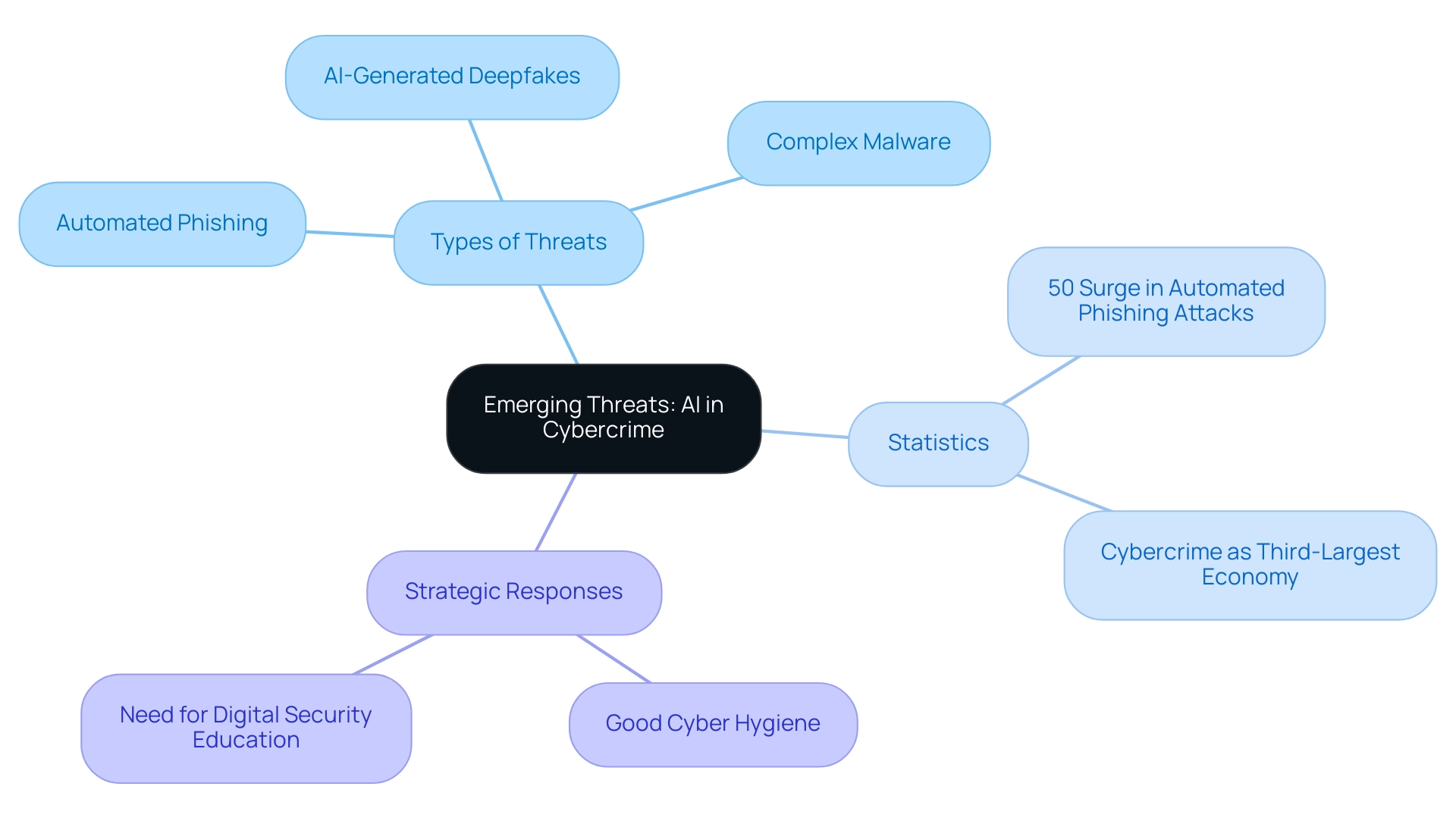
Advancements in AI Technologies for Enhanced Cyber Defense
Recent advancements in AI technologies have significantly changed cybersecurity defenses, illustrating the future of AI in cyber security as essential tools in the ongoing battle against cyber risks. Predictive analytics, for instance, empowers organizations to anticipate potential risks before they materialize, providing a strategic advantage in risk management. Automated incident response systems exemplify this proactive stance, enabling rapid neutralization of dangers with minimal human intervention.
AI-driven information and event management (SIEM) systems are particularly noteworthy; they efficiently analyze vast amounts of logs and alerts, effectively prioritizing incidents based on severity and potential impact. Such capabilities are vital, particularly as recent reports suggest that:
- 4 in 5 Chief Information Security Officers (CISOs) have encountered an increase in risks amid economic challenges.
- 31% reporting project delays or cancellations due to lack of funding.
Cybersecurity experts anticipate that the use of AI to counter AI cyber attacks will become a long-term battle of 'AI vs. AI.' This proactive approach not only enhances protective measures but also enables tech teams to focus their efforts on intricate threats that require human expertise. As the digital security landscape evolves, the future of AI in cyber security will likely become increasingly pivotal, with a compound annual growth rate of 21.9% projected for the AI digital security market, underscoring the critical role these advancements play in contemporary defense strategies.
Moreover, public confidence in AI is essential for its acceptance; while 50% of consumers regard AI positively, concerns about safety and misuse are common, as emphasized by a Pew Research study indicating that 39% of adults are at ease with AI in healthcare.
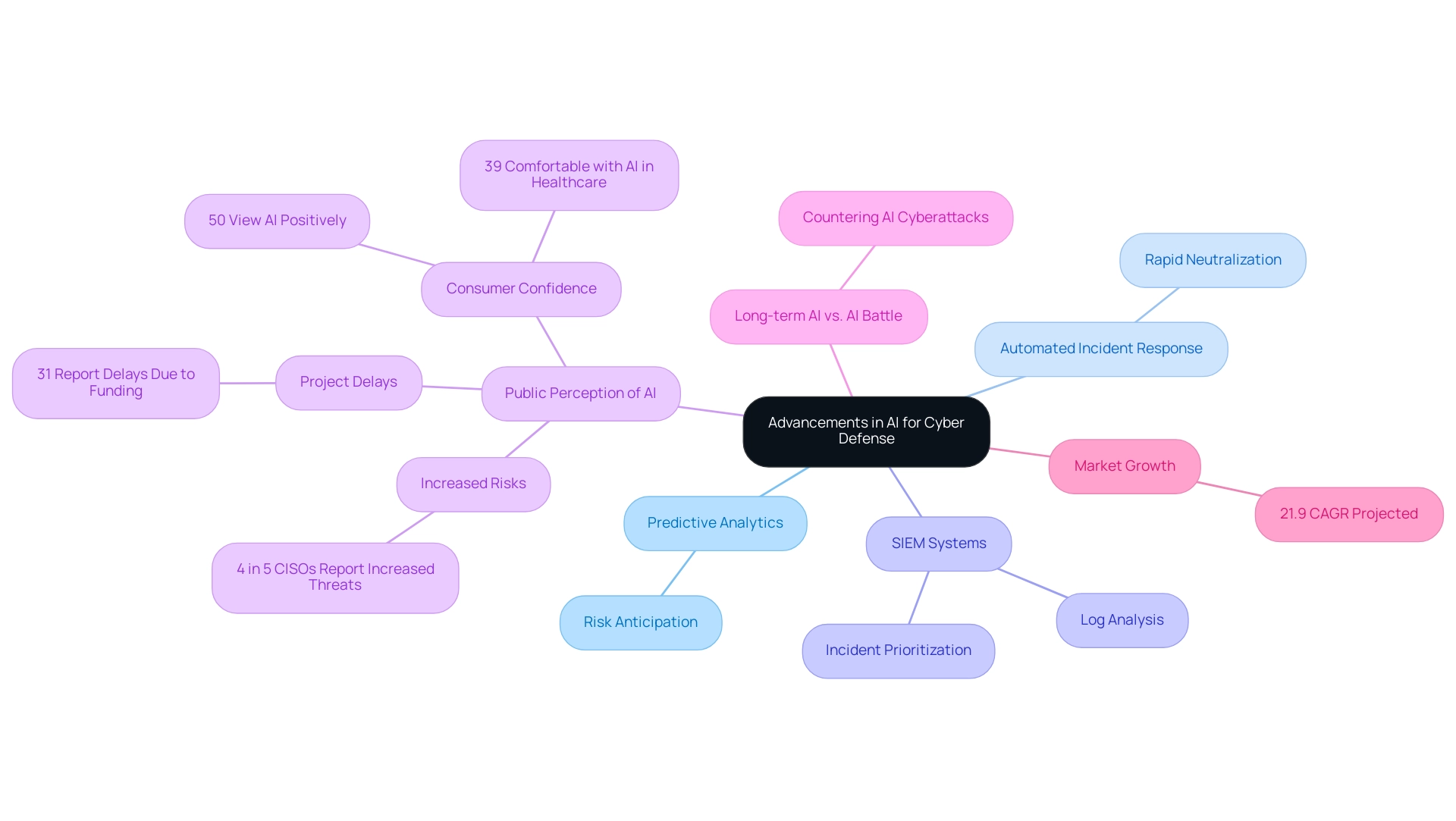
Bridging the Cybersecurity Skills Gap with AI
The information protection sector is presently struggling with a significant skills gap, leaving numerous organizations at a disadvantage in managing their operations effectively. This gap is highlighted by findings from the Skills Gap Report, which revealed that IT decision-makers identified a lack of protective skills and training as the leading cause of breaches. In this context, the future of AI in cyber security emerges as a pivotal solution.
By automating routine security tasks, AI enables existing personnel to devote more time to strategic initiatives and tackle complex challenges. Furthermore, organizations that have integrated AI into their prevention workflows have saved an average of $2.2 million in breach costs, emphasizing AI's effectiveness in improving security measures. AI-driven tools are also crucial in the training and upskilling of employees, providing them with the essential knowledge to navigate a rapidly evolving digital security landscape.
These tools can analyze performance metrics and provide tailored training suggestions, ensuring that security teams are skilled at addressing emerging threats. As mentioned in the Skills Gap Report, boards of directors are increasingly interested in digital security, examining skills challenges and prioritizing the hiring of diverse talent pools. Furthermore, as Jim Johnson, Senior Vice President of Technology at Robert Half, highlighted, many employers are now willing to provide higher salaries for technology talent with in-demand skills in security, emphasizing the importance of skilled professionals in this critical field.
Leveraging AI not only enhances operational efficiency but also plays a crucial role in the future of AI in cyber security by fostering a more competent workforce capable of safeguarding organizations against sophisticated cyber threats.
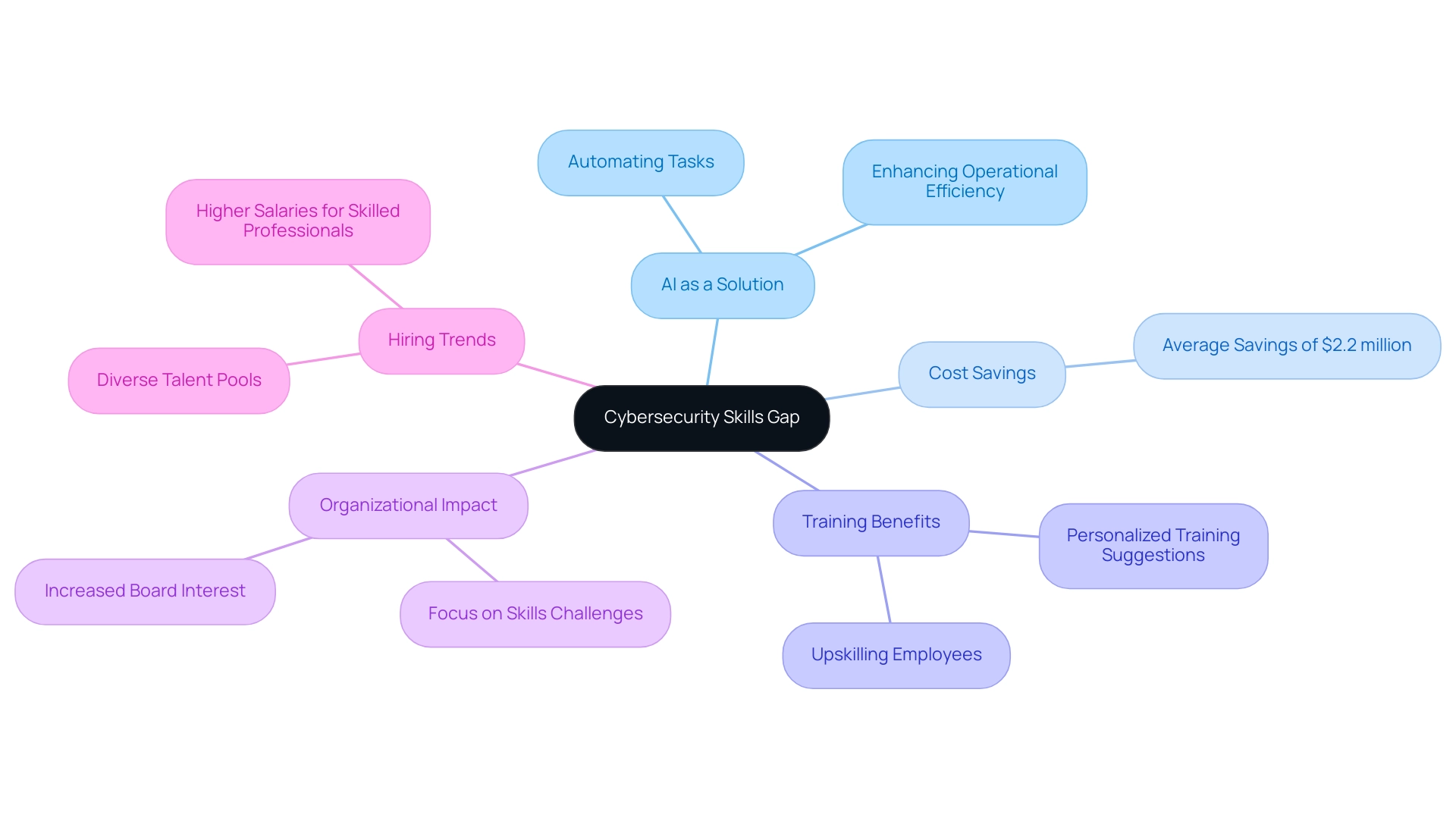
Future Implications: Ethics and Regulations in AI Cybersecurity
As artificial intelligence increasingly becomes a cornerstone of security strategies, the future of AI in cyber security is leading to a rapidly evolving ethical and regulatory landscape surrounding its use. Organizations face critical challenges, including:
- Data privacy
- Algorithmic bias
- The need for accountability in AI-driven decision-making
Recent data underscores the urgency of these concerns, with ransomware attacks surging 13 times in the first half of 2023 as a percentage of total malware detections.
Experts predict a long-term battle of 'AI vs. AI' in countering AI cyber attacks, which underscores the future of AI in cyber security and the need for robust strategies. Regulatory bodies are responding by formulating guidelines that govern AI's application in digital security, highlighting the future of AI in cyber security with a strong emphasis on transparency and ethical practices. For instance, companies may soon be mandated to disclose the decision-making processes of AI algorithms in threat detection and response scenarios.
More than 70% of enterprises utilizing AI in digital security are now creating protocols that permit manual evaluations of AI-generated decisions, which underscores the future of AI in cyber security and the need for accountability. A survey revealed that while 96% of business executives anticipate security breaches stemming from generative AI adoption, only 24% of the projects currently integrate cybersecurity measures. This disconnect, as showcased in the case study titled 'Disconnect Between AI Adoption and Cyber Security Measures,' underscores a critical gap in understanding and implementing necessary safeguards.
As the landscape continues to shift, organizations must proactively address these ethical implications to uphold trust and ensure compliance with emerging regulations.
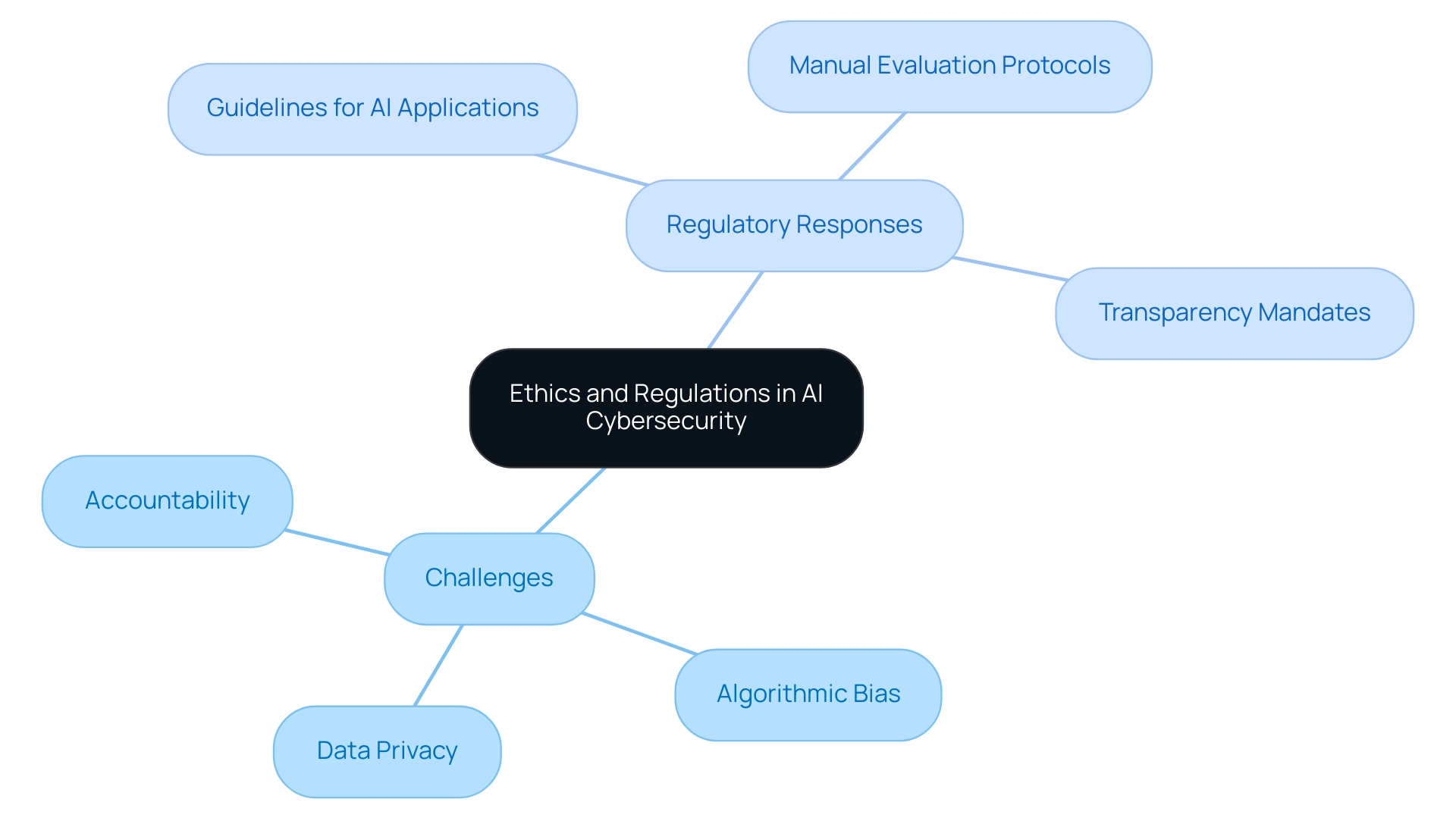
Conclusion
The integration of artificial intelligence in cybersecurity marks a significant evolution in how organizations safeguard their digital assets against an array of sophisticated threats. As highlighted throughout the discussion, AI enhances threat detection and response capabilities, allowing for rapid analysis of vast datasets and the automation of security processes. This technological advancement is crucial in an environment where cybercriminals are increasingly leveraging AI to execute more sophisticated attacks, such as automated phishing and AI-generated deepfakes.
Moreover, the challenges posed by the misuse of AI cannot be overlooked. The growing prevalence of cybercrime, coupled with alarming statistics regarding ransomware and automated attacks, necessitates a reevaluation of existing cybersecurity strategies. Organizations must adopt a proactive stance that not only incorporates AI technologies but also emphasizes the importance of human expertise and ethical considerations in their implementation.
As the cybersecurity landscape continues to evolve, bridging the skills gap through AI-driven training and upskilling initiatives is imperative. This approach not only enhances operational efficiency but also equips cybersecurity professionals with the knowledge needed to combat emerging threats effectively. Additionally, the ethical and regulatory frameworks surrounding AI use in cybersecurity must be prioritized to ensure accountability and trust.
In conclusion, the transformative role of AI in cybersecurity is undeniable. Organizations must embrace these advancements while remaining vigilant about the ethical implications and potential misuse of the technology. As they navigate this complex landscape, a commitment to innovation, compliance, and continuous improvement will be essential in protecting against the ever-evolving threats that lie ahead.




